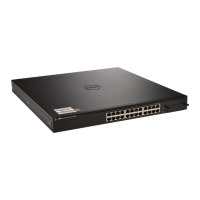Configuring Link Aggregation 791
28
Configuring Link Aggregation
This chapter describes how to create and configure link aggregation groups
(LAGs), which are also known as port channels.
The topics covered in this chapter include:
• Link Aggregation Overview
• Default Link Aggregation Values
• Configuring Link Aggregation (Web)
• Configuring Link Aggregation (CLI)
• Link Aggregation Configuration Examples
Link Aggregation Overview
Link Aggregation allows one or more full-duplex (FDX) Ethernet links of the
same speed to be aggregated together to form a LAG. This allows the switch
to treat the LAG as if it is a single link.
The PowerConnect 8000/8100-series switches support industry-standard
LAGs that adhere to the IEEE 802.3ad specification. The maximum number
of LAGs that may be configured is limited to the maximum number of ports
possible in the switch stack or stand-alone switch divided by two. This allows
for a flexible configuration of LAGs where LAGs may have up to eight ports
or as few as two ports. You can configure LAGs until all ports in the system are
assigned to a LAG.
Assignment of interfaces to dynamic LAGs is based on a maximum of 144
interfaces assigned to dynamic LAGs, a maximum of 72 dynamic LAGs and a
maximum of 8 interfaces per dynamic LAG. For example, 72 LAGs may be
assigned 2 interfaces each, or 18 LAGs may be assigned 8 interfaces each.
Each PowerConnect 8000/8100-series switch supports a maximum of 7 static
or dynamic LAGs. Each LAG can consist of up to eight 10 Gbps ports. When
eight 10 Gbps ports are configured as a LAG, the maximum bandwidth for
the single, logical interface is 80 Gbps.

